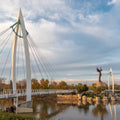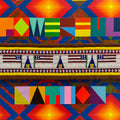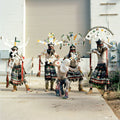Artists take up the call of protecting California's Giant Kelp forests
By Chadd Scott on
A warming planet means warming waters, too. With all the climate induced heat waves, forest fires and floods wreaking havoc on land – where we live – it’s easy to forget humanity’s carbon emissions are having an equally devastating impact on marine life. On coral reefs and fish, and off the California coast, Giant Kelp.
The Birch Aquarium at Scripps Institute of Oceanography at UC San Diego in La Jolla has enlisted a trio of local artist/scientists to reinforce this connection during the exhibition, “Hold Fast,” on view through Labor Day 2024.
Guests weave through a labyrinth of cyanotype-printed giant kelp by photo-based artist Oriana Poindexter, dive into the details of local species via gyotaku prints from Dwight Hwang, and peer into the tiny world of kelp propagation with Scripps Oceanography PhD student Mohammad Sedarat.
“Warming waters and Giant Kelp don’t mix,” Birch Aquarium Exhibits Director Megan Dickerson said. “To grow and reproduce, Giant Kelp needs cool water. Giant Kelp are resilient and can handle a warm year every few decades or so. What it can’t handle are year after year of warm waters, with extreme spikes like the 2015 marine heatwave, also called ‘the Blob.’ Like any of us, there’s only so much it can handle.”
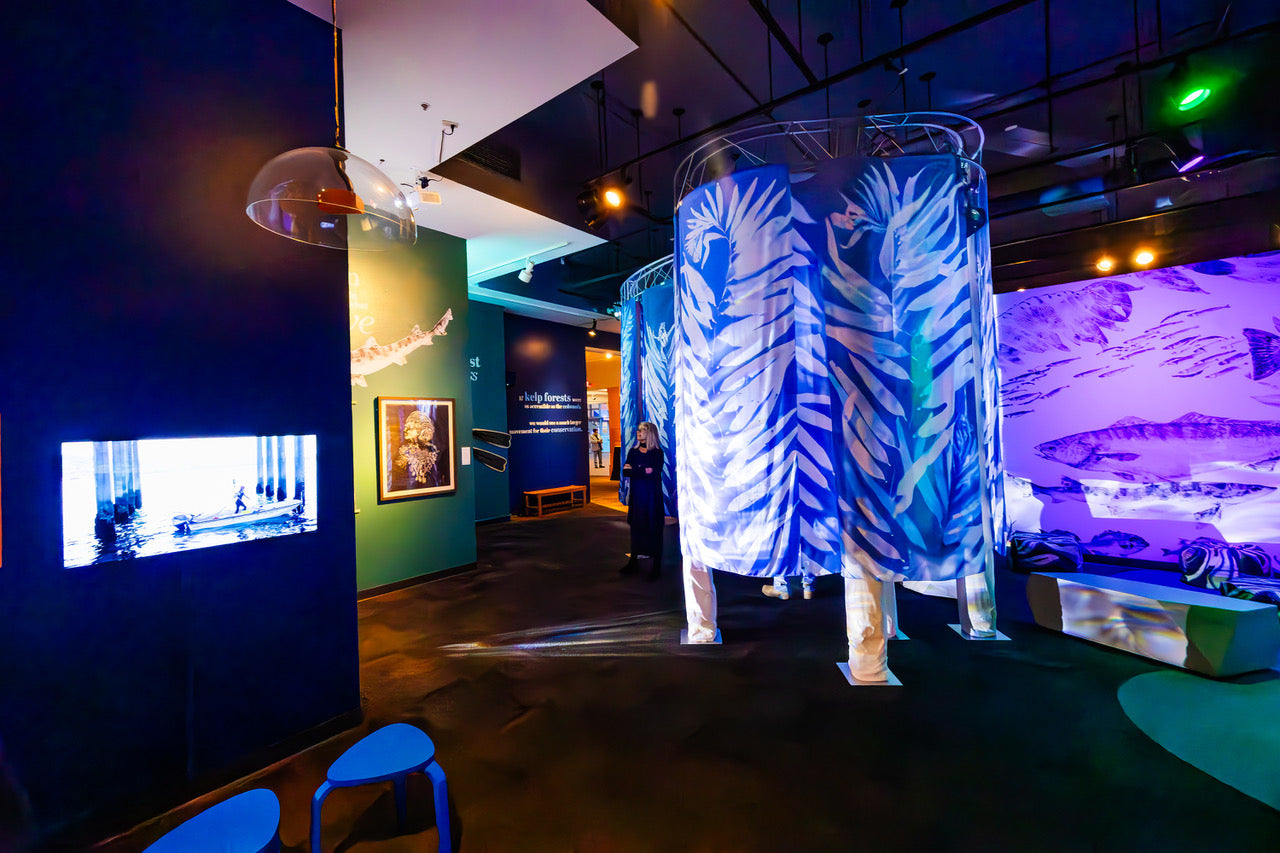
Giant Kelp, which is not a plant, but a type of algae, can grow up to a foot a day, reaching lengths of more than 150-feet. In addition to supporting a wide variety of sea life – purple sea urchins, sea stars, sponges, lobsters, squid, sharks and otters, who wrap themselves in the kelp while sleeping to prevent floating away – Giant Kelp also serve humans in critical ways.
“Giant Kelp acts as coastal breaks for a lot of the heavy wave action that would otherwise hit our coasts,” Dickerson explained. “If we lose kelp forests, we lose one of our biggest allies in fighting coastal erosion.”
Scientists have known all of this for decades. Activists have been shouting it for decades. Museums showing exhibitions for decades.
What can artists add to this conversation that hasn’t already been said?
“Art creates emotional connection and inspires us to see things through a different lens,” Dickerson said. “‘Hold Fast’ brings the community into the science and closes the gap between scientist and community member so that we see how not only are we all connected to one another, but also fundamentally connected to our ocean.”
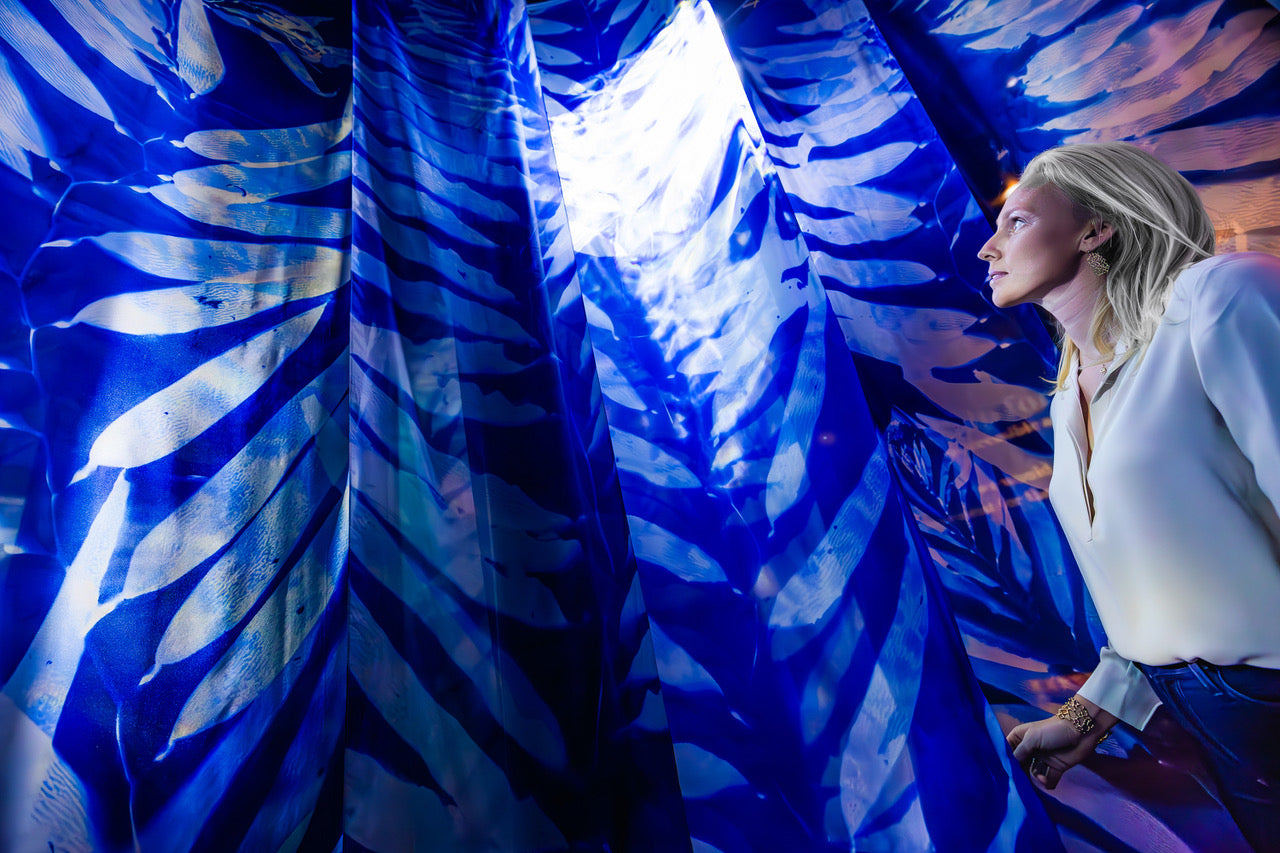
Art Meets Conservation
A central feature of the Birch Aquarium since the building opened in the early 1990s has been a Giant Kelp Forest habitat visitors walk through. Increasingly, the aquarium is using art to augment nature.
Last year, a sound installation by Gabriel Zalles-Ballivian, “Talking with Fish,” was added to the display. The artwork identifies and tracks different clusters of fish within the underwater environment. Each cluster is treated as an individual musical entity, and its coordinates become a synthesized musical composition.
“Hold Fast” furthers the aquarium’s efforts of helping guests connect to nature more deeply through art.
Poindexter is an artist, marine scientist, and the exhibition’s co-curator. She has been documenting the changes in La Jolla’s local kelp forests for years. In “Hold Fast,” her life-sized cyanotype prints on fabric create a stunning kelp forest for guests to explore without the barrier of glass intervening or having to go out into the ocean.
Hwang is a classic Japanese gyotaku artist. The word “gyotaku” breaks down into two parts: ‘gyo’ meaning ‘fish’ and ‘taku’ meaning ‘rubbing’ or ‘impression.’ Obscure in the United States, gyotaku is commonplace in Japan.
The gyotaku process involves using a brush to swab calligraphy ink made of pine soot and water, called Sumi, directly onto the surface of the fish. A sheet of Japanese paper made from mulberry bark, called Washi (Kozo), is then pressed onto the inked surface to produce a print.
Everything from the girth of the fish to its overall size, scales and fins determines the specifics of the ink and paper Hwang uses on each animal to achieve his dramatic results.
For Birch Aquarium, Hwang’s prints focus on kelp forest fish found off La Jolla shores, allowing guests an even closer view of these fascinating species.

Sedarat is a PhD Student at the Smith Lab at Scripps Oceanography whose research explores the impact of climate change on La Jolla’s kelp forest. His work on view provides up-to-the-minute kelp forest mapping that explains why critical Giant Kelp ecosystems have not returned since recent marine heatwaves and explores what can be done to bring them back.
Inspiration for the exhibition came from Poindexter, who had recently begun collaborating with Hwang.
“Oriana came to us with the idea of exhibiting her cyanotype prints on silk to create an immersive kelp forest that people could touch and walk through, along with a display of Dwight’s gyotaku prints of fish from local forests,” Dickerson explained. “At the same time, the Aquarium had just signed on to help a scientist, Mohammad Sedarat, with his research on Giant Kelp. He’s identifying heat-resilient strains of Giant Kelp and growing baby kelp in his lab, but Giant Kelp is exactly that– it gets giant! He needed a place to finish growing his kelp, and our Giant Kelp habitat was the perfect place.”
The Birch Aquarium exhibits team saw the important work these three artists and scientists were doing, all around Giant Kelp and climate change, and were intrigued to show how they were going about their connected work in different ways, matching their specific skill sets and passions.
“This exhibit is truly a bridge between (scientists, artists and the community), and shows how each of us has a role to play, and no part is too small,” Dickerson said. “We thought that showing these three local people’s work, and telling their stories, was a great way to give some hope to the community—and to inspire the community to take action themselves.”
That action can come in many forms from voting, to reducing single use plastic consumption – like plastic bottles – to volunteering.
For anyone interested in learning more, the UC San Diego Library is hosting an accompanying exhibit, “Ebb and Flow: Giant Kelp Forests through Art, Science and the Archives, at Geisel Library” through April 21, 2024. Uniting archival material with contemporary art, that exhibit showcases works created as a result of continued observation of the local Giant Kelp forest environment by artists, scientists and community members over the past 134 years.
